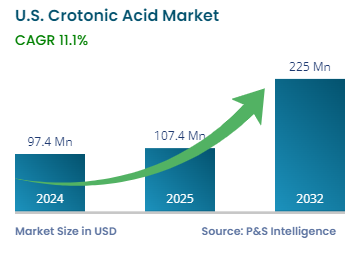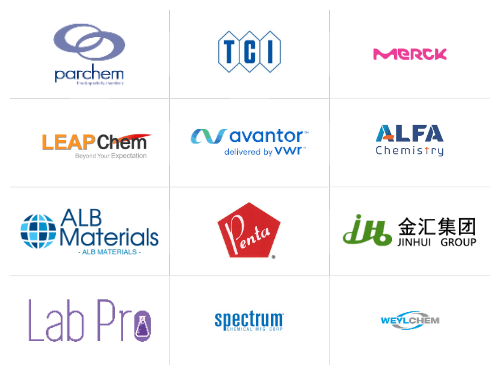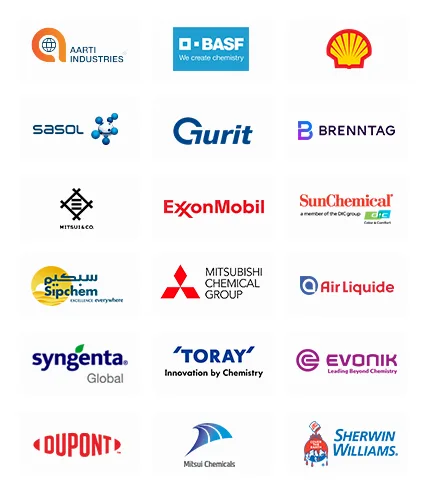U.S. Crotonic Acid Market Growth Factors
Increasing Demand in Pharmaceutical and Cosmetics Industries Is a Key Trend
Crotonic acid-based copolymer coatings, being bio-compatible, are used in the pharmaceutical and personal care industries. Mixing crotonic acid and vinyl acetate forms a copolymer, which is used as a film-forming agent in aerosol hair sprays and other hair preparations.
Moreover, the increasing research and development on biologics and complex medicines drive crotonic acid utilization. A common drug that contains crotonic acid is crotamiton, which is used for reducing the sensation of itching and treating scabies. As per a study, almost 15% of the American population suffers from scabies at any time, reflecting a high demand for crotonic acid for the production of crotamiton.
Furthermore, the cosmetics industry applies crotonic acid for skincare product formulations, including anti-aging creams, moisturizers, and serums. Personal care and cosmetics companies appreciate crotonic acid because it helps other ingredients penetrate better, maintains skin hydration, and contributes to lightening the complexion of the dermis.
As per the Washing State Department of Correction, the average consumer in the U.S. spends USD 28 on makeup, USD 15 on haircare products, USD 23 on moisturizers, and USD 17 on anti-aging products each month. The cosmetic industry now offers customized skin care products; hence, crotonic acid, alongside other specific ingredients, are gaining increasing popularity.
Industrial Growth and Demand for Specialty Chemicals Are Biggest Growth Drivers
The increasing production of adhesives, coatings, and polymers in the U.S. drives the growth of the market. This is because the production of polymeric dispersions, which serve as essential components for paints and coatings and adhesives, requires substantial volumes of crotonic acid.
In this regard, the expansion of the construction, automotive, and packaging sectors becomes a key growth factor for the market. According to the U.S. Census Bureau, USD 2,192.2 billion was poured into construction in the country in December 2024, which was 0.5% more than the November 2024 spending of USD 2,180.3 billion. Similarly, 10,611,555 vehicles were manufactured in the country in 2023, compared to 10,060,339 in 2022, says OICA.
The industrial sector requires additional polymers specifically for packaging applications, automotive components, and textiles. Products containing crotonic acid-based copolymers benefit from higher flexibility, strength, and environmental resistance.
Short Shelf Life Is Maor Challenge
The chemical stability of crotonic acid and other substances diminishes when they encounter heat, UV light, and water. The chemical instability forces manufacturers to set storage restrictions on crotonic acid because the substance deteriorates quickly, which can be harmful for the pharmaceutical and coating sectors.
In addition, the limited time crotonic acid remains viable requires manufacturers and distributors to maintain specially controlled storage facilities, leading to added expenses. Controlled environments are vital because premature degradation occurs if the chemical is stored without proper conditions, which leads to supply chain complications.
Furthermore, purchasing large stocks poses challenges to users in maintain their final products’ quality. Expired crotonic acid weakens end products and creates additional expenses through product losses, thereby impacting production costs.
U.S. Crotonic Acid Market Competitive Landscape
The market is fragmented in nature because crotonic acid stands as an important chemical utilized in pharmaceuticals, cosmetics, adhesives and coatings, and plastics. The diverse industrial requirements lead to the entry of multiple manufacturers specializing in various applications.
Small and medium-sized enterprises that specialize in cosmetics and specialty coatings play a major role in fulfilling market-specific requirements. Such enterprises direct their operations toward individual applications, instead of seeking complete market coverage.
Several chemical production entities exist throughout the market, together with various regional suppliers of crotonic acid who work alongside international companies. Market competition remains intense due to the presence of numerous participants and the fact that none of them commands a controlling share.
While global chemical companies maintain control over several market segments, they lack complete dominance in all application fields, thus preserving market dispersion.
U.S. Crotonic Acid Companies:
- ALB Technology Limited
- WeylChem International GmbH
- Tianjin Jinhui Pharmaceutical Group Co. Ltd.
- Penta Manufacturing Company
- Spectrum Chemical Manufacturing Corporation
- Merck KGaA
- Leap Chem Co. Ltd
- VWR International, LLC
- Lab Pro Inc.
- Tokyo Chemical Industry Co. Ltd.
- Parchem
- Alfa Chemistry



